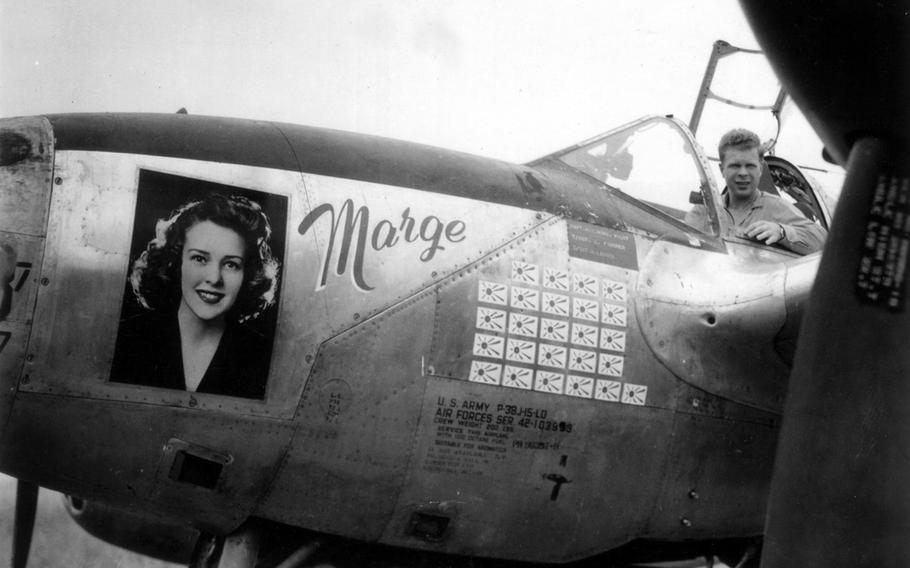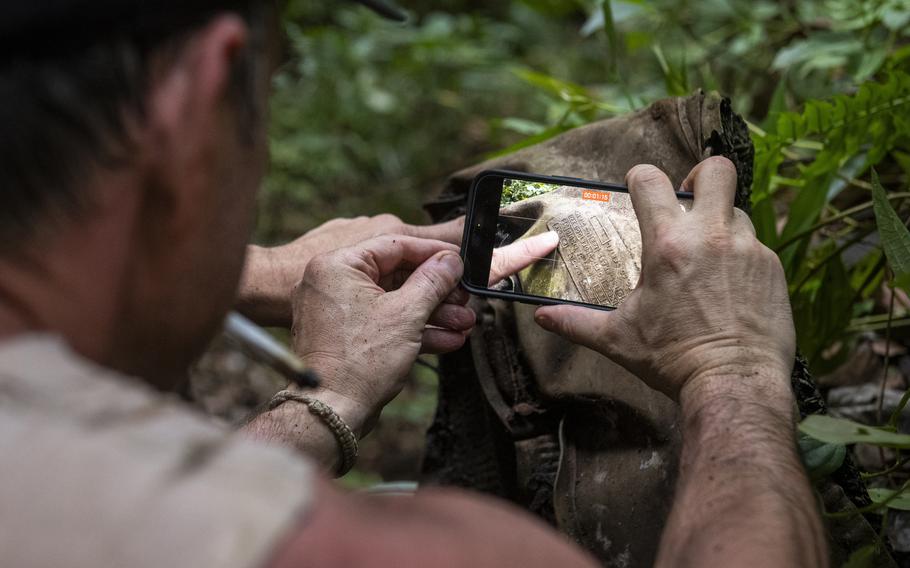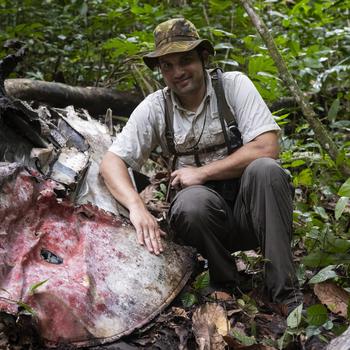
In this photo taken in March 1944 in the Pacific, Richard Bong, then a captain in the U.S. Army Air Force, sits in the cockpit of his P-38 fighter plane adorned with an image of his girlfriend, Marge, and a scoreboard tallying his 25 aerial victories over Japanese aircraft. (U.S. Army Air Force)
The wreck of a P-38 fighter flown by America’s all-time top flying ace was found last week, 80 years after it crashed in the jungles of Papua New Guinea.
Capt. Richard I. Bong, who was credited for shooting down 40 Japanese planes during World War II, had named his P-38 “Marge” after his girlfriend, whom he later married.
Another pilot, while flying the plane on March 24, 1944, on a weather reconnaissance mission over New Guinea, bailed out due to an electrical malfunction on the plane.
Earlier this year, the Richard I. Bong Veterans Historical Center in Superior, Wis., and Pacific Wrecks announced that they had joined together to find the wreck. On Thursday, the museum announced that the Pacific Wrecks team had located the wreckage on May 15 in thick jungle in Madang Province, Papua New Guinea.
Serial numbers confirmed
The team found several serial numbers on the wreck that confirmed it was the P-38 flown and customized by Bong, museum curator Briana Fiandt told Stars and Stripes by phone Thursday.
The museum hosted a news conference during which Justin Taylan, the search team leader and director of the nonprofit search-and-recovery organization Pacific Wrecks, participated via livestream from Papua New Guinea.
Fiandt said that Taylan described the plane as having crashed nose first into the ground, burying the aircraft’s two engines.
All that could be seen above ground were propeller tips, so none of the plane’s distinctive markings made by Bong were visible, she said.

Steve Kleiman and Justin Taylan, director of Pacific Wrecks, document information May 16, 2024, on a radiator data plate on wreckage in Papua New Guinea from a P-38 plane once flown by World War II flying ace Richard Bong. (Joel Carillet)
Bong had placed a large portrait of his girlfriend, Marjorie Vattendahl, on the plane’s nose. Near her image was a scoreboard tallying his aerial kills.
The Pacific Wrecks team has no plans to dig the plane out of the ground, Fiandt said.
The team did, however, find a part of the plane far from the crash site.
They had noticed a unique bench in the village that was home to those who helped lead the team to the crash site, she said. The bench, they later learned, was one of the P-38’s wings that villagers had brought back from the crash site decades ago and refashioned into furniture, she said.
Bong, a Wisconsin native, had joined the U.S. Army Air Corps in May 1941 as an aviation cadet and a year later was commissioned as a second lieutenant in the Army Air Force.
He took quickly to flying, making the most of the powerful and agile P-38, which was the fastest fighter plane existing at the outbreak of World War II.
By December 1942 he had shot down his first two enemy planes over Buna, New Guinea. At five aerial victories a month later, he earned the title of “ace.”

Justin Taylan, director of Pacific Wrecks, poses May 16, 2024, in Papua New Guinea at the crash site of a P-38 fighter once flown by flying ace Richard Bong. (Joel Carillet)
Decorated ace
In April 1944, he exceeded the 26 aerial kills claimed by America’s top World War I ace, Edward Rickenbacker, making Bong the highest scoring ace in U.S. history, a title still standing.
Along the way he was awarded the Silver Star, Distinguished Service Cross and Medal of Honor.
Bong flew a series of P-38s during the war, but the one found last week was the most highly celebrated. After it was assigned to him in February 1944, he named it and customized it.
The public ate up the newspaper accounts of Bong’s flying prowess and his devotion to his girl back home. He was credited with three aerial victories while piloting this homage to Marge.
On March 24, 1944, 2nd Lt. Tom Malone took Marge up for what would be her last flight when he bailed out at about 11,000 feet.
Bong, who was promoted to major, went on to fly more missions in other planes, racking up 40 aerial victories before he was brought back to the U.S. mainland in early 1945.
There, he married Vattendahl, promoted war bonds and became a test pilot for the first jet fighters.
Bong died on Aug. 6, 1945, in a crash while test flying a P-80 Shooting Star jet fighter in Southern California.